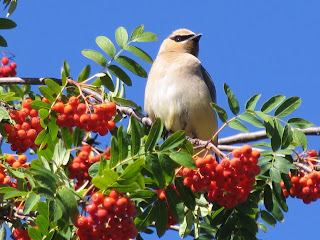WAXWINGS
WINGIN’
IT
By
Kate Crowley
In a recent column I
talked about the unexpected encounters with birds that add to our daily
enjoyment of nature. A week ago Mike and
I were out cross-country skiing near our house when we heard a flock of birds
making an unfamiliar sound. We stopped
and looked up into the top of a Jack Pine and saw them moving from branch to
branch. Because it was a sunny day, it was hard to see their colors clearly
because they were so strongly backlit, but we both came to the conclusion that
they were Waxwings. The question was;
Cedar or Bohemian? Neither one of us had
binoculars, but Mike has better long distance vision than me and he was able to
see their features better.
In order to bring them
closer I started ‘pishing’. I have
talked about this technique before. It
is just as it sounds. You purse your
lips and make a ‘pishing’ sound –sort of like ‘shushing’ someone in the
library, but using a ‘p’ at the front.
In more cases than not, this sound will intrigue the birds enough to
bring them closer to you. Gradually,
this flock of waxwings moved from the pine to an oak tree that was closer to
us. They still stayed in the top of the tree, but moved from branch to
branch. I’m not certain what they were
looking for because typically waxwings eat dried fruits in the winter
months.
I continued to ‘pish’
and they continued to move around giving us a better look at their
plumage. Both Cedar and Bohemian
Waxwings are very pretty birds with a soft grayish body plumage, a bright
yellow marking on the edge of their tail and some red waxy looking ‘droplets’
on the tips of their secondary wing feathers. Both have a crest of feathers on
their heads, although it is not always raised up and both have a black mask and
some rusty colored feathers on their heads.
What we were able to
see from our position below were rufous colored under tail coverts and some
white wing bars. This was all we really needed
to ID these birds as Bohemian Waxwings – a very exciting discovery, since we
have never seen them in our neighborhood.
Bohemian waxwings tend
to spend more of their lives in the far north of Canada. Each winter some might wander south in search
of better food sources, but in the past we have only seen them far up the North
Shore. Their calls were different than
the Cedar Waxwings too and as soon as we got home we went on-line and listened
to recordings of the birds; this was another way of confirming what we had
seen.
The name Bohemian was
given to these birds because of their wandering habits, supposedly like the
Gypsies of Bohemia. They are the size of
a starling and have broad, pointed wings and short tails. While fruit is their preferred food, in the
summer months they will hunt for flying insects. We often see Cedar Waxwings in Banning State
Park perched in trees along the river’s edge.
They will fly out from the tree, grab an insect in the air and then
return to their perch.
In winter, waxwings will
eat birch seeds, juniper berries, rose hips and crabapples, but they especially
love the fruit of mountain ash trees. Any
fruiting tree or shrub that is not denuded by squirrels or other birds are
attractive to these elegant birds.
I recently put my
‘pishing’ technique to use in the mountains of Montana. My son Jon and I were cross-country skiing in
an area called Hyalite Canyon. The groomed trails used old logging roads, so we
were surrounded by Lodgepole Pine and
Douglas Fir trees. It was quiet
in these woods, but at one point we stopped and heard the high pitched
chittering of Chickadees. If there are any birds susceptible to pishing, it is
Chickadees. Their innate curiosity
causes them to quickly search out this unusual sound. Within moments, a small flock of Mountain
Chickadees converged on the branches of the trees close to us.
I admit that at elevation
I have a bit more trouble keeping up this constant sound, but for as long as I
did it, they hopped around, calling to one another. There may have been a Black-Capped Chickadee
and a Red-Breasted Nuthatch in the bunch, since they too are drawn by these calls. My son has seen me do this before, but it is
always a thrill to feel like Dr. Doolittle talking to the animals.
I encourage you to try
‘Pishing’ sometime too. It may not work
every time, but when it does, it’s magical.




Comments
Post a Comment